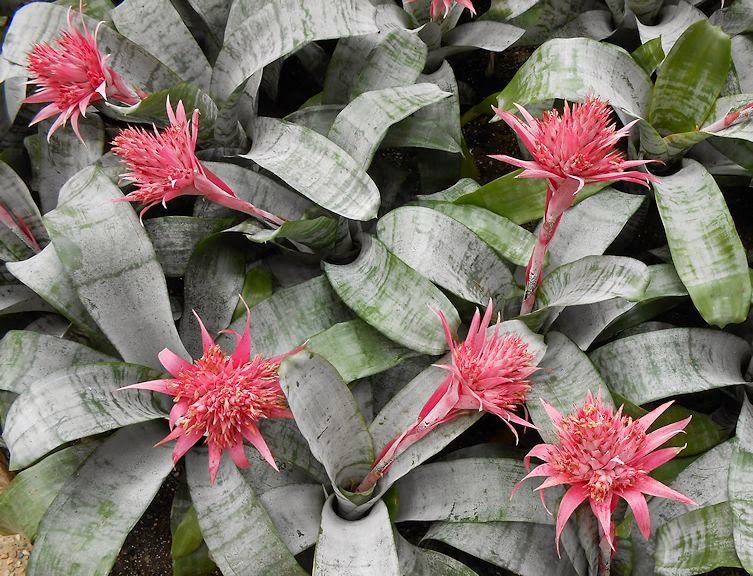Adjoining the great Conservatory are two large Exhibition halls. This one can be flooded,
as you see above and I saw on my first day, or drained and filled with chairs for a concert,
as it was on my third day there. There is a huge pipe organ with 10,000 pipes in the room
at the far end, and its sound fills this hall.
In the foreground are Broad Leafed Pink Hydrangeas.
Hanging from the ceiling are baskets of Broad Leafed Blue Hydrangeas.
Matilde Burns pink Hydrangeas
Baskets of Delft Blue Broad Leafed Hydrangeas
Basket of Broad Leafed Delft Blue Hydrangeas
The West Side Aisle is lined with Marguerite Daisy Trees. Delft Blue Hydrangeas,
Pale Pink Freesia, Pink Stock back against the wall, and Pink Urn Flowers.
Pink Stock and Blue Hydrangeas, with mirrored wall reflections.
Lace Cap Hydrangeas. Instead of large clusters, they produce a ringlet of flower.
Short-stemmed Blue Hydrangeas.
Blue Hydrangeas
Pink and White Freesia blooming profusely
Pink and White Freesia
Urn Plant, a member of the Bromeliad family.
The other aisle was hung with baskets of Rose Grape Medinilla and Asparagus Ferns
A Rose Grape Medinilla Flower. Gorgeous.
On the third day of my visit, the Easter Lilies and some of the Canterbury Bells were gone,
and in their place were these bright Salpiglossa / Painted Tongues. The plant exhibits
are being changed daily; as a plant begins to be less than perfect, it is removed and another
plant from the greenhouses is brought in to replace it.
Painted Tongue / Salpiglossa.
Salpiglossa / Painted Tongue. It comes in many color combinations.
Exhibition Hall B has ponds, waterfalls, over 2000 different plants and actually four parts:
this one with the water, the Garden Path, the Camellia House, and the Children's Conservatory.
Looking from Exhibition Hall B to Exhibition Hall A with pink Canterbury Bells
in the doorway.
The tall plants are Blue Towers of Jewels. The lower, frothy blue is made up of
Forget-Me-Nots; and the pink are Stock flowers.
Blue Towers of Jewels, Forget-Me-Nots, and Pink Stock.
White Calla Lilies in the Upper Pond
A Lily-of-the-Nile
Yellow Calla Lilies in the Children's Conservatory
Pale Lemon Clivia. This flower is from South Africa but has become
a standard at Longwood.
Pale Lemon Clivia
Orange Clivia
Exhibition Hall B
There are several areas on either side with rocking chairs, where you can sit,
partially concealed by foliage, and just enjoy the beauty.
Medium Sized blue Towers of Jewels
The Garden Path is a wonderful meandering path lined with flowers that anyone
could grow in their year, to give visitors ideas. Nothing exotic here, but good old
flowers you could find any place. These are African Iris, but they are common
in American now and quite hardy.
A single African iris. They grow on tall, thin stalks and are quite hardy and
multiply quickly.
Osteospermum are colorful, hardy flowers with bright colors.
Astilbe comes in various soft colors, but always like the most delicate lace.
It grows very easily and almost becomes a weed.
White Japanese Pieris looks almost like Astilbe and grows on a bush in early spring.
Variegated Blue Potato Vine. This is a decorative member of the potato family and
does not produce a vegetable. We have a lot here in Florida, but the leaves are a soft
pea-green all over and the flowers are medium sized and soft blue. This is a new
variety with variegated leaves and smaller two toned flowers/
Skullcap Flower. These clusters are about 5 inches high.
Three Skullcap flowers.
Desert Rose, about six inches in diameter. The Desert Rose we have in Florida or
Arizona has smaller red or red and white flowers.
White Gerbera Daisies. Everyone should have Gerbera Daisies in their garden.
They are hardy, colorful, prolific, spread easily, and are easy to grow.
_








































No comments:
Post a Comment